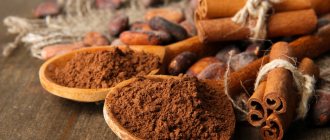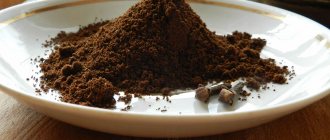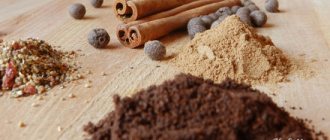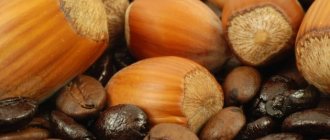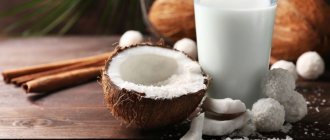For those who are tired of classic coffee preparation options, it is worth taking a closer look at other culinary techniques. With their help, you will not only get new taste sensations, but also reduce the harmful effects of coffee drinks on your body. The essence of this trick lies in the addition of spices. It makes no sense to say which spice will be better and which will not. It all depends on everyone's personal taste preferences. Some people like coffee with the addition of nutmeg, others like it with ginger, cinnamon, cloves and even salt.
Features of the effect on the body
The cinnamon stick contains a huge amount of vitamins, including A, B, E. Nutmeg is rich in calcium, zinc, phosphorus and essential oils. When combined with each other, these spices have a healing effect on the body.
When brewed correctly, a ready-made drink containing these 2 components helps:
- export toxins and waste from the stomach;
- stimulate the gastrointestinal tract;
- normalize blood pressure;
- improve metabolism (metabolism), lose weight;
- relieve unpleasant odor in the mouth;
- reduce pain during menstruation;
- normalize the monthly cycle;
- calm your nerves;
- improve memory and concentration.
Also, the benefit of coffee brewed with these ingredients is to strengthen immune defense. The human body who regularly consumes it is less susceptible to attack by pathogenic viruses and bacteria.
In folk medicine, spicy espresso is used to treat impotence in men and insomnia in women. However, to achieve the desired effect, it must be brewed correctly.
These products cannot be eaten in their “pure” form. If you chew on a cinnamon stick, you will experience severe nausea, which may alternate with vomiting.
There are cases when the use of these spices by a person ended in a coma.
There are categories of people for whom it is extremely undesirable to add any spices to dishes and drinks:
- pregnant and breastfeeding women;
- epileptics;
- people with unstable blood pressure;
- children under 10 years of age;
- allergy sufferers.
Abuse is fraught with the development of a pathological process in the body.
Contraindications for use
Coffee also has negative qualities, for example:
- Reduces the amount of magnesium, calcium and B vitamins - important microelements.
- Worsens the well-being and general condition of the body of people who suffer from mental, cardiovascular and nervous diseases.
- Adversely affects the development of the fetus during pregnancy.
- Causes addiction.
Coffee with nutmeg and cardamom is considered a tonic drink, which increases sexual desire, activates the heart and increases the energy of the body.
Nutmeg and Cinnamon Coffee Recipe
This is a traditional way of preparing spicy espresso. You will need:
- ground Arabica;
- granulated sugar (optional);
- nutmeg;
- cinnamon stick.
First you need to prepare the coffee beans. They should be sorted, washed, dried and fried over a fire.
The concentration and color of the drink depend on the degree of roasting of the coffee beans. The longer you leave them on the stove, the more bitter the espresso will be.
When the raw materials for the cocktail are ready, pour it into the Turk. Add sugar to taste and spices. Fill everything with water. You need to boil the liquid well. The container is removed from the stove at the moment a brown fluffy foam forms on its top. As soon as the cream settles, return the Turk to the stove and repeat the action. This manipulation will help make the taste of the drink more rich. This recipe will prepare a spicy hot espresso in just 5-7 minutes.
To prevent coffee grounds from spoiling the ceremony, strain the hot product. It is recommended to let it sit for a couple of minutes before using it.
If desired, the top of the cup in which the drink is served can be decorated with whipped cream and grated chocolate.
How to drink correctly
It is customary to drink oriental coffee hot immediately after removing the Turk from the heat. Pour it directly from the grounds into small ceramic or porcelain cups. Guests must be served a glass of clean cold water and placed to the left of the cup.
It is necessary in order to fully experience the taste of the drink and replenish fluid loss. It is not customary to serve sugar and a teaspoon, since this additive is already in the drink.
Guests are given a saucer with oriental sweets or cream
In the east, it is customary to serve coffee according to seniority. Hospitable hosts offer guests 3 cups of drink, and asking for more is considered bad manners. The cup is held in the right hand with the thumb and forefinger. Coffee is drunk in small sips, savoring and enjoying the rich taste.
Oriental coffee is not an easy drink! It carries the traditions and culture of distant countries that have developed over centuries. No matter how many recipes you take, the principle of preparing such coffee will be the same and if you follow it, you will always get an excellent result.
With chocolate syrup
Spices are added to coffee for 2 reasons. Firstly, to impart a rich aroma, and secondly, to improve taste.
Nutmeg goes well with chocolate syrup, so it is recommended to combine these ingredients. In addition to them, you need to take sugar, half a teaspoon of cinnamon, mineral water and ground Arabica.
Cooking method:
- First you need to fill the Turk with all the ingredients except chocolate syrup. If you wish, you can prepare it yourself. To do this, mix a spoonful of cocoa with granulated sugar, add a small amount of water to the mixture and place in a water bath for 5 minutes.
- Fill the Turk with ground Arabica, cinnamon, sugar and nutmeg. Put it on fire. Remove from the stove when a creamy brown foam forms on top. As soon as it settles, return the container to the fire. Repeat the action twice.
- Strain the mixture using a strainer. Without waiting for the drink to cool, pour the chocolate syrup into it.
You don’t have to pour the nutmeg into the Turk right away, but sprinkle it over the finished espresso. Whipped cream will complement the composition.
Choosing the right fruit
Indonesian and Grenadian nutmegs can be found on sale. The first one is orange in color, it has a more pronounced aroma and taste, the cost of this seasoning is somewhat more expensive.
The Grenada fruit is not so bright in color, it has a yellowish skin and a milder aroma and taste. It is Indonesian products that are valued in the world. In Indonesia, not only the seed is used, but also the pulp of the fruit.
When choosing, look at the size of the seed; the average size nut is about 1.5-2 cm in diameter. The color of the dried fruit is light brown, brown. Fruit with damage, mold, or chips is not worth buying.
A high-quality nut cannot be crushed by hand; if the fruit is soft, this indicates that it is not fresh.
How much nutmeg can you eat?
A safe dosage is considered to be 1 nutmeg per 10 kg of human weight.
The daily norm is approximately 30 g (2-3 pcs.) per day.
Macis
Macis is the most suitable substitute. Mace is the red membrane surrounding the nutmeg. Both spices are extracted from the same plant - fragrant nutmeg.
This spice will be the best substitute for nutmeg. In almost all recipes it is used in the same proportion.
It should be borne in mind that this spice is not an absolute analogue of nutmeg, since the smell of nutmeg is quite delicate, it does not contain many notes of the aroma of this product. Its advantage is that it is very similar, which is why it is the first choice when looking for a nutmeg substitute.
Cooking with yolk
Hot coffee with egg yolk is prepared in a specific way. To cook it you will need the following components:
- granulated sugar (preferably brown);
- mineral water;
- ground robusta or arabica beans;
- nutmeg;
- yolk;
- a little cinnamon;
- heavy cream.
First you need to brew traditional espresso using any method. Nutmeg and coffee go well together, but to give the drink a more pronounced taste and aroma, it is also recommended to add a pinch of cinnamon.
The recipe includes the combination of 3 preparations. While the first one is brewing - espresso - take care of the other 2. The cream needs to be heated over a fire, but not brought to a boil. Whisk granulated sugar with egg yolk until fluffy foam appears.
Fill the glass with strong coffee, then milk and egg ingredients, sprinkle with cinnamon to taste. Mix the mixture well until it becomes homogeneous.
If you want to add oriental notes to the taste of a hot, invigorating drink, then Arabica beans need to be ground together with whole nuts.
Whatever recipe you follow, the main thing is to bring the liquid to a boil several times. During cooking, spices reveal their aromatic potential. You will be able to feel the pleasant aroma of this coffee within the first minutes of its preparation.
New taste of familiar coffee
It is unlikely that now there is a settlement where no one likes to enjoy a cup of aromatic coffee. This hot drink is suitable at any time of the day. In the morning, coffee helps you get out of bed faster and get into the mood for work. During the day it supports performance, and in the evening it promotes relaxation.
We often add milk, cognac, cinnamon, condensed milk or cream to our coffee. But what if the taste of your favorite drink is already boring and some “zest” is missing? In this case, baristas add a variety of spices and herbs. Plus, you can do this yourself at home. The main thing is not to be afraid to experiment.
Adding nutmeg to coffee will give the drink a bitter and spicy taste, making it more warming. However, you should not use ground spice from a bag. It is better to grind the product yourself before preparing the drink. This will make the taste and aroma more rich and piquant.
SPICES AND WORLD HISTORY
Science and life // Illustrations
Ships of Magellan's expedition in the Strait of Magellan.
Ferdinand Magellan (1480 - 1521), the famous Portuguese navigator who completed the first circumnavigation of the world.
Carrack "Victoria" from Magellan's expedition.
A branch of true cinnamon. Cinnamon oil is extracted from cinnamon leaves and used in perfumery.
A spice obtained from the bark of the cinnamon tree.
In the picture there is a fragrant nutmeg: a branch with buds, a fruit and an aryllus.
From the dried seed, an aromatic spice is obtained - nutmeg (photo below), from arillus - the spice nutmeg, or mace.
Branch of a blooming clove tree. The finished spice is dried unopened flower buds.
Science and life // Illustrations
‹
›
In September 1522, the dilapidated four-masted carrack "Victoria", under the command of captain Juan Sebastian d'Elcano, heavily swaying from side to side, dropped anchor in the port of San Lucar de Barrameda at the same pier near the coast of Spain, from where three years earlier, On September 20, 1519, 265 people sailed on five ships under the leadership of Ferdinand Magellan. Of the five ships, only Victoria was lucky enough to return, with eighteen crew members remaining on board. Staggering, they went ashore, knelt down and kissed their native land. Magellan's greatest seafaring feat was completed. In addition to general admiration for the great victory of the human spirit, the return of the ship caused delight among the people who financed the expedition. They had long been ready to write off at a loss the money spent on equipping the expedition. But the returning sailing ship delivered about 24 tons of cinnamon, nutmeg and cloves. Selling them to cover all expenses for Magellan's expedition could also bring net profit.
The spices were loaded into the hold of a sailing ship in the Moluccas, the discovery of which at one time influenced the course of world history. Marine expeditions, equipped to find lands from which fabulously expensive spices came to Europe, marked the beginning of great geographical discoveries, including proof of the spherical shape of the Earth, the discovery of the Pacific and Indian oceans, numerous islands and peoples. The lucrative trade in expensive goods that followed laid the foundation for the creation of European colonial empires, which, in turn, largely determined the face of the modern world.
CINNAMON AND CASSIA
Back in biblical times, Phoenician merchants brought to the Mediterranean countries two spices necessary for the preparation of myrrh, an incense used in the Christian church. These were the now familiar cinnamon and the still familiar cassia. Both spices are the bark of trees or shrubs known as cinnamon. Cinnamon is obtained from the bark of the true cinnamon (commercial name “Ceylon cinnamon”), and cassia is obtained from the bark of the aromatic cinnamon (commercial name “Chinese cinnamon, or cassia”).
True cinnamon (Cinnamomum verum
J. Presl) is an evergreen tree from the laurel family up to 10 m high. Its homeland is Sri Lanka and South-West India. Now it is cultivated as a shrub throughout the tropical zone of the globe.
Cinnamomum aromaticum
Nees) is an evergreen tree from the same laurel family, up to 15 m high. It grows wild in the humid subtropical mountain forests of Southern China. Cultivated in China, Southeast Asia, Madagascar, Brazil and other subtropical and tropical countries.
Less known on the European market are Indian cinnamon (trade name “Malabar cinnamon”) and Indonesian (trade name “spicy cinnamon” or “cinnamon”).
On plantations, cinnamon trees are grown as shrubs. Strips of bark 30 cm long and 1-2 cm wide are harvested from one- to three-year-old shoots after the end of the rainy season. The roughest outer part of the bark is scraped off and a thin layer is separated. Dry it in the sun until it turns yellow-brown. The thick inner bark is kept in the shade until it turns dark brown and curls into a tube.
The thickness of Ceylon cinnamon after drying barely reaches 1 millimeter, Chinese cinnamon - 2 mm or more.
In the countries of Southeast and Central Asia, the greatest demand is for Chinese cinnamon, or cassia, which has a rather pungent odor and an astringent taste with a hint of bitterness. In Russia and European countries, Ceylon cinnamon is more valued with its more subtle aroma and less astringent taste. Both types of cinnamon are very popular in the Arab countries of the Middle East and North Africa.
In the old days, cinnamon was highly valued not only as a spice, but also as a medicine that stimulates appetite, strengthens the stomach, and promotes digestion. But her ability to “excite lust and voluptuousness” was even more valued. However, gradually cinnamon lost its medical significance and completely became a spice, retaining, however, its fame as an aphrodisiac, the charming smell of which, as before, is credited with the ability to eliminate nervousness and arouse desire.
From a modern point of view, all types of cinnamon contain biologically active substances that stimulate appetite, enhance digestion and make it easy to digest fatty foods. This spice has a beneficial effect on well-being at any age, and its use only improves the quality of life for elderly people with poor health. Just a pinch of cinnamon can turn low-fat kefir, oatmeal with water and other dietary dishes from daily torture into pleasure and delicacy.
Much higher than all other varieties, Ceylon cinnamon is valued in cooking because it has a subtle, refined “oriental” aroma, a “cinnamon” smell and a sweet, slightly pungent taste. It is especially good in sweet dishes, such as fruit soups, casseroles, compotes, jelly, puddings, rolls, pies with berry filling, baked apples, jams, and drinks. It is customary for many nations to season tea and coffee with it. It is recommended to add a small amount of ground cinnamon to ground beef or to pork chops and schnitzels before frying. In general, cinnamon sticks are used in stewed poultry, pork and lamb dishes.
This spice should not be used only if you are prone to bleeding, and it should be completely excluded from the diet of pregnant women.
Cinnamon apparently came to Russia at the same time as nutmeg and cloves. It is difficult to say when this happened, but the earliest mention of it can be found in Domostroy, a Russian literary monument of the 16th century, the full name of which is “The book called Domostroy, containing useful information, teachings and instructions to every Christian - husband and wife, and children, and servants, and maidservants." In Russian cuisine, this spice was and remains one of the most beloved, used to flavor homemade baked goods, gingerbread cookies, cookies and sweet dishes.
Almost all Russian national drinks were scented with cinnamon: sbitny, kvass, honey, fruit drinks, water, whey with raisins. It is part of a variety of spices, but a mixture consisting of equal amounts of ground cinnamon and ground allspice is especially popular.
Nutmeg and Nutmeg
Fragrant nutmeg (Myristica fragrans
Houtt) is an evergreen dioecious tree 16-20 m high from the Muscataceae family. Its homeland is the Moluccas Islands. They are cultivated on the islands of the Malay Archipelago, in India, Sri Lanka, on the islands of the Caribbean, in Brazil. From the female flowers of this plant large orange-yellow or gray-yellow bivalve fruits with a diameter of 4-7 mm develop. Each fruit contains one large seed, covered with a hard dark brown shell, surrounded by a succulent appendage (aryllus).
Dried seedlings are sold under the name nutmeg, or mace. The seeds, freed from the auricles and undergoing complex processing, are known in the trade as nutmeg.
To obtain nutmeg, or mace, the seeds are carefully squeezed out of the seedbeds (resulting in the formation of holes), then they are dried in the sun and flattened with wooden rollers, and when completely dry, they are carefully packaged. A whole, undamaged nutmeg is much more expensive than a broken one.
Benign mace is a hard, very fragile, slightly translucent plate 3-4 cm long, 2-3 cm wide and 1 mm thick, colored light orange or dark yellow with a hole in the center and 10-15 lobes along the edges.
Large seeds extracted from the fruit are first dried in the sun, and then on bamboo sieves, under which a small (smokeless) fire is maintained around the clock for one and a half to two months. Every day, by the end of the day, the seeds are turned over with a wooden rake. In dried seeds, the shell easily separates from the core. Remove it by carefully breaking it with wooden hammers. To protect against mold, pest damage and germination, the freed kernels are immersed for several minutes in a mixture of seawater and lime obtained from corals. After which the kernels are dried again in air in the shade for one to three weeks.
The finished spice is a gray-brown kernel 2.5-3 cm long and up to 2 cm wide. The aroma of the spice depends on the shape of the nuts: large and round ones have a more subtle and rich aroma than oblong ones.
Along with nutmeg, extracted from the fragrant nutmeg, less valuable plant seeds of other types of nutmeg are traded: Papuan, or Macassar, obtained from the silver nutmeg, and Bombay, harvested from the Malabar nutmeg.
Nutmeg is found much less frequently on the world market than nutmeg and is therefore much more expensive. In the first half of the 19th century, its price was four times higher than the cost of nutmeg, by the end of the 19th century this difference was halved, and today nutmeg is only 25-30% more expensive than nutmeg.
Nutmeg and nutmeg contain substances that stimulate digestion and have antibacterial, anti-inflammatory, decongestant, antispasmodic and analgesic effects. This goes some way to explaining why nutmeg was credited with powerful abilities in the fight against epidemics of gastrointestinal diseases in the Middle Ages. Nutmegs were often used as amulets that could equally protect against the wiles of the devil and infectious diseases. For this purpose, nutmegs were constantly carried with them in a box made of silver and ivory, one side of which was a miniature grater.
In popular literature you can find a statement that nutmegs contain substances that have a hallucinogenic effect, which manifests itself when the spice is consumed in very large quantities, but scientific research has not confirmed this.
Nutmeg and nutmeg have many uses in modern cooking. Spices have a refined warm aroma and a spicy-burning piquant taste that varies in shades. The nutmeg color has a more pronounced woody smell and bitter taste.
Nutmeg and nutmeg are consumed both separately and together - they complement each other and enhance the aroma and taste of each other. They can be used to season fresh vegetable salads, homemade sausages and pates, cottage cheese and cottage cheese dishes. The spice goes well with meat broths, soups, especially chicken and vegetable soups, and puree soups. They are indispensable in cases where you have to cope with the digestion of copious amounts of fatty beef, lamb, and pork. These spices are especially in harmony with chicken dishes. Nutmeg is good for flavoring boiled potatoes, mashed potatoes and potato cutlets, dishes made from white, red, Brussels sprouts and cauliflower, and mushrooms baked in the oven. The spice goes well with scrambled eggs and omelettes, rice, pasta and homemade noodles, pancakes and pancakes. Nutmeg imparts a pleasant aroma to pies and pie fillings made from onions, cheese, and meat. Spicy and pickled herring, spicy small fish, and hot smoked fish are prepared with it. Nutmeg and color add flavor and flavor to various sauces for meat and poultry. In English and German cuisine they prefer to add more nutmeg to sauces, and in French and Italian cuisine they prefer to add more nutmeg. In European cuisine, a nutmeg-colored aromatic essence has found application, which is used in the preparation of mustard, ketchup and in the canning industry.
Nutmeg is truly irreplaceable in desserts. Cupcakes and Easter cakes, sweet pies and pies, cookies, gingerbread, puddings, fruit cakes, custard become much tastier if grated nutmeg is added to them.
Previously, nutmeg and nutmeg were often used to flavor vodkas.
CARNATION
Sweet clove (Syzygium aromaticum
(L.) Meеrr. et Perry) is an evergreen tropical tree 10-12 m high from the myrtle family. Its homeland is the Moluccas Islands. The main producers of this spice in the modern world are India, Sri Lanka, the Moluccas, as well as the Caribbean islands and the islands of Pemba, Zanzibar and Madagascar.
The Russian name for the spice comes from its Latin name “clavus”, which was given because of the shape of the bud, which resembles a nail. The “nail head” is formed by a calyx with four red sepals, four folded white-pink petals, numerous stamens and a bright stem, which is an overgrown receptacle with an ovary.
To obtain the spice, unripe buds are picked from trees that have reached six years of age, dipped in boiling water for a few minutes, and then dried in the sun. As a result, they acquire a dark brown color with a reddish tint, a strong, unique aroma and a pungent, bitter taste. The quality of the spice can be checked in a very simple way: just throw a bud into water. In a “quality” spice, the bud sinks or floats vertically with the cap up.
The main value of cloves is in the essential oil of complex composition, the content of which can reach 15%. In addition to essential oil, the buds contain proteins, fats, carbohydrates, amino acids, alkaloids, vitamins B1, B2, trace elements, flavonoids, anthocyanins, salicylic acid, sterols, tannins, resins and mucous substances.
In the kingdom of spices, cloves occupy a special place due to their aromatic qualities, but it is interesting that they are practically not used in the cuisine of the Moluccas and Indonesia. Local residents, the main consumers of this spice, prefer to add it to tobacco. Clove flavored cigarettes are extremely popular and their sweet aroma fills Indonesian homes, restaurants, shops and offices. But as a spice, cloves are very popular in China, Sri Lanka, India, the countries of the Middle East and the Arab countries of North Africa, where they are used in meat and vegetable dishes, rice, sweets and drinks.
Until recently, necklaces made from clove buds were considered an effective remedy to help avoid infection with the plague, and a decoction of the buds served as a reliable medicine against cholera. In traditional Indian medicine, cloves were used as a pain reliever and it was believed that regularly adding it to food elevates mood and increases sexual activity.
In Europe during the early Middle Ages, cloves were used to make incense, less often used as medicine, and even less often used as a spice.
The first description of cloves in European literature is found by the Roman author Pliny in his famous work Natural History, written in the 1st century AD. It follows from it that in ancient medicine, cloves were considered a remedy that strengthens the stomach and liver, facilitates breathing in various diseases of the respiratory tract, relieves toothache, improves memory, and ignites love. In medieval European medicine, cloves were considered an effective remedy against plague and other epidemic diseases. Cloves began to be used as a spice only with the advent of the Renaissance and the time of the Great Geographical Discoveries.
From a modern point of view, clove buds contain biologically active substances that have bactericidal, fungicidal, insecticidal, anti-inflammatory, analgesic, antispasmodic, carminative and antipruritic effects.
In almost all countries of the world, cloves are used in meat dishes from pork, lamb, and game. It is added when pickling herring and cooking marinated fish, added to pickled vegetables and canned fruits, juices and compotes, confectionery and hot drinks with wine, and added to tea and coffee.
In Russian cuisine, this spice is used in the preparation of pickled mushrooms and hot dishes of mushrooms, sauerkraut, and pickled apples. It is added to jam and dough, whipped cream, mustard, and sauces.
When using cloves as a spice, food digestion is significantly improved, gas formation in the intestines is reduced, and the risk of infectious gastrointestinal diseases is reduced. It has been scientifically proven that food flavored with cloves stimulates libido.
Cloves should undoubtedly be considered a spice with beneficial properties for humans, but excessive use of it can cause intoxication phenomena, accompanied by a slight disorder of the function of the higher parts of the central nervous system.
SPICES IN DESSERTS AND DRINKS
Apple pie with cinnamon
One package of ready-made puff pastry, 4 sweet and sour apples, 2 tbsp. l. sugar, 1 tsp. ground cinnamon, powdered sugar.
Divide the dough into two parts and roll out. Cut the apples in half, core them, cut into thin slices and place on one half of the dough. Sprinkle with sugar and cinnamon. Place the other half of the dough on top and pinch the edges. Bake for 15 minutes in an oven heated to 180°C. Sprinkle the finished pie with powdered sugar.
Cinnamon tea
1 cinnamon stick, 2 tsp. black Ceylon tea, 0.5 liters of water, sugar to taste.
Pour 0.5 liters of boiling water over a cinnamon stick, leave for 10 minutes, heat again almost to a boil and pour into a preheated dry kettle into which black tea is poured. Leave for 4-5 minutes and pour into cups.
Dessert “apple in a handkerchief”
One package of ready-made puff pastry, 6 apples, 200 g of curd mass with raisins, 3 tsp. honey, 1 tsp. cinnamon.
Cut out 6 squares measuring 15x15 cm from the rolled out puff pastry. Cut out the core of the apples and fill it with cheese mixture, honey and cinnamon. Wrap each apple in a square of dough, pinch the corners on top and place in the oven on a greased baking sheet. Bake for 20-30 minutes at 170°C. Let cool and sprinkle with powdered sugar.
Natural coffee with cinnamon
1 a cup of hot coffee, 1 cup of hot milk, a pinch of ground cinnamon, a pinch of grated nutmeg, 1 tbsp. l. whipped cream, chocolate chips, sugar.
Pour milk and coffee into a tall glass, stir with sugar, sprinkle with cinnamon and nutmeg, top with whipped cream and chocolate chips.
Instant coffee with cinnamon
For 6 servings: 4 tbsp. l. instant coffee, 1/2-1 tsp. ground cinnamon, 2 tbsp. l. sugar, 1.2 liters of milk.
Combine sugar and cinnamon in a large saucepan, then heat over low heat, stirring constantly. Pour in coffee dissolved in hot milk, stir over low heat and bring to a boil. Let cool slightly and serve.
Sbiten Suzdal
150 g honey, 150 g sugar, 5 g each of cloves, cinnamon, ginger, cardamom, bay leaf, 1 liter of water.
Add honey to boiled water. Bring the mixture to a boil and boil for 20 minutes, then add sugar, spices and boil for another 5 minutes. Strain the drink and serve hot.
Mulled wine
Mulled wine is prepared from inexpensive red dry or semi-dry weak wine (House wine class - homemade wine) with the addition of sugar, cinnamon, cloves, nutmeg and other spices. Spices are added whole or coarsely crushed. Rum, cognac, liqueur, and lemon juice will give this drink a pleasant aroma, but in such quantities that its taste does not become harsh.
Mulled wine should under no circumstances boil; the temperature of the finished drink cannot be higher than 70°C. If it contains hot water, it is boiled immediately before use and poured carefully along the edge of the vessel.
Mulled wine is drunk hot from tall glasses with a handle or ceramic cups. The drink does not tolerate cooling at all - reheated wine loses its bouquet and taste.
Mulled wine will warm you up, relieve fatigue, help get rid of colds and coughs, and cope with frayed nerves.
Mulled wine classic
1 a bottle (0.75 l) of dry red wine, cloves - 6-7 pcs., nutmeg - to taste, water - 1/3 cup, sugar - 1 tbsp. spoon.
Place cloves and ground nutmeg in a pot, add 1/3 cup of water, bring to a boil, boil for 1 minute and leave for 10 minutes.
Pour the wine into a saucepan and put on fire. When it warms up, add the contents of the turk and 1 tbsp. spoon of sugar.
Mulled wine “Autumn”
Dry red wine - 1 bottle (0.75 l), water - 400 ml, sugar - 100 g, cognac - 100 ml, cinnamon - 5 g, cloves - 10 g, 1 lemon.
Heat all ingredients, except lemon, in a saucepan until boiling, let stand for 10-15 minutes and strain. Then pour in the cognac and pour into heated glasses, dipping a piece of lemon into each.
Clove punch
1.5 l red port, 100 ml sugar syrup, 100 ml orange liqueur, 2 oranges, 12 pcs. cloves, grated nutmeg.
Stick the cloves into the oranges and place the fruits in a preheated oven. Leave until the orange peel turns brown. After this, cut the fruits into slices, put them in a small enamel pan and pour in sugar syrup, orange liqueur and port wine. Boil the mixture over low heat for 15 minutes, pour into cups and sprinkle with grated nutmeg.
Note to the hostess
• Since in culinary recipes the quantity of spices is mentioned either in pieces, sometimes in grams, sometimes in spoons, it is useful to know that one clove bud weighs about 0.08 g, a teaspoon contains 5 g of this spice, a tablespoon - 18 g.
One teaspoon contains 5 g of ground cinnamon, a tablespoon - 15 g. One nutmeg weighs 6 g, a teaspoon contains 7 g of grated nut, a tablespoon - 20 g.
• In dishes that require heat treatment, add cinnamon powder at the very end of cooking (no more than 10 minutes before the end), otherwise this spice will give them an unpleasant bitterness.
• Add ground cinnamon to cold dishes before serving; in baking - when kneading dough, in filling or in a finished dish. The average amount of spice used is 1/5 to 1/4 teaspoon per serving.
• Grated nutmeg quickly loses its flavor, so it is better to buy and store whole nuts and chop them as needed. Store the spice out of reach of sunlight in a tightly closed container.
• Nutmeg is added to meat and hot vegetable dishes before the end of cooking; in the dough - during kneading; in sweet hot dishes - after cooking. The norm is 0.1 g of powder (at the tip of a knife) per serving.
• Particular care is required when using cloves: during heat treatment, the aroma is partially lost and the pungency increases. For 1 kg of dough, 4-5 buds of ground cloves are enough, for soups and broths - 1 bud per serving, when pickling mushrooms - 2 g per 10 kg of product.
• In Russian cuisine, spice mixtures, which include cloves, cinnamon and nutmeg, are most often used to prepare vegetable marinades. An example is a mixture for pickling cucumbers, tomatoes and mushrooms, which contains: 1 part each of cloves, white or black pepper, allspice, coriander seeds, white mustard, as well as 1-2 pods of hot dried red pepper and 3 bay leaves. The mixture of the listed spices is placed in a gauze bag and dipped into the marinade being prepared, and after the marinade is prepared, discarded. Less commonly, a mixture of these spices is placed directly into jars when canning. Sometimes this mixture is infused with vinegar, which is used to prepare the marinade.


